#tribe era at least
Explore tagged Tumblr posts
Note
‘ you are a wild , unkempt thing ’ (affectionate) to yang

Were it anyone else to remark that to her, Yang might have been offended. But Yang looks up at her mom with a raised eyebrow, in the process of filling out a paper. Pen hovers, before being set down as Raven cards her fingers through her daughters messy locks of hair.
"I learned that from you."

"I think the only thing I learned from Taiyang was how to make bad jokes."
#varnaedhar#You’re FREE to DO;; Whatever PLEASES YOU [Yang] {Reversal AU}#variable age#tribe era at least#Paint me in a portrait;; Sans the FIG LEAVES [Raven Branwen] {Varnaedhar}
1 note
·
View note
Text
Introducing more characters for my HTTYD/The Deep story! Only this time it’s supporting cast! I’ve decided there’s three overall casts in the story. The main cast (the dragon riders and their dragons, whose story and travels this lengthy project follows), the secondary cast (all their allies and enemies; Eret, Dagur, Heather, the Berkians, the Nektons, etc, etc.) who are there through most of the story, but not all of it. They’re pretty involved, but not every character is there for every episode. And then there’s the supporting cast. Minor characters. Characters a step up from background characters. They show up for a few episodes every once in a while, not near as often as everyone else, and they’re not as important to the overall story as the main and secondary casts, but they have names. They’re involved in certain arcs and episodes, but don’t repeatedly show up throughout the story like say, Dagur, Eret, Heather, the Berkian teens, and the Defenders and Wingmaidens.
But without further ado, here’s who I’ve got so far
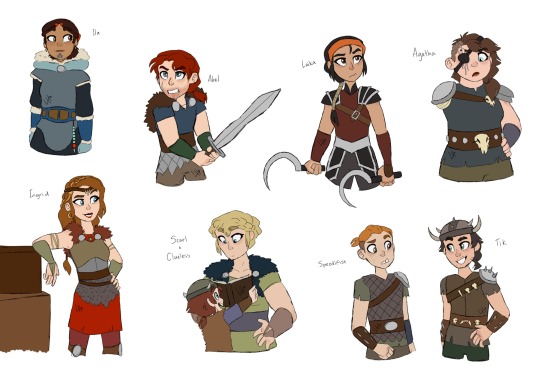
And some closeups of each person, cause I like doing so
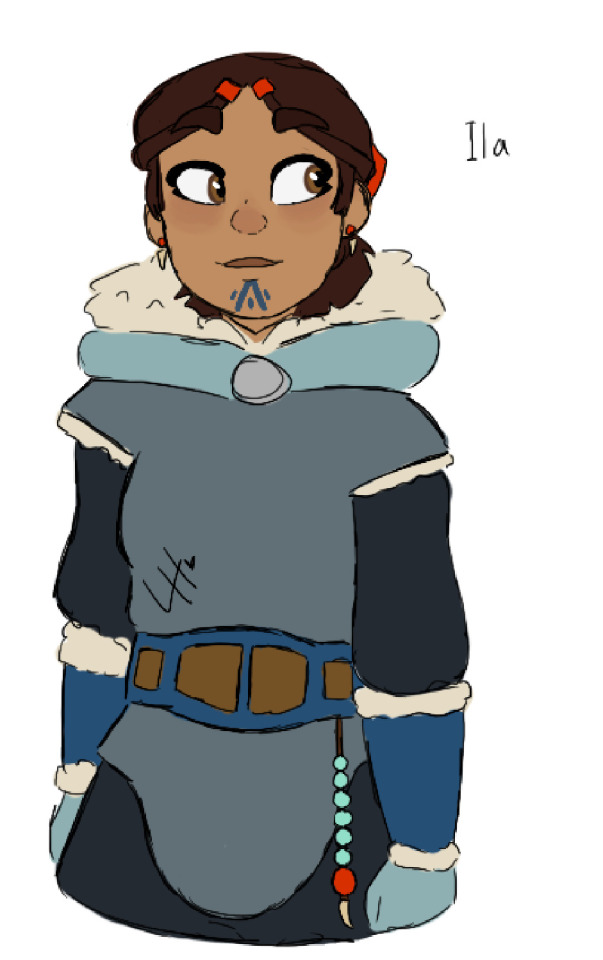
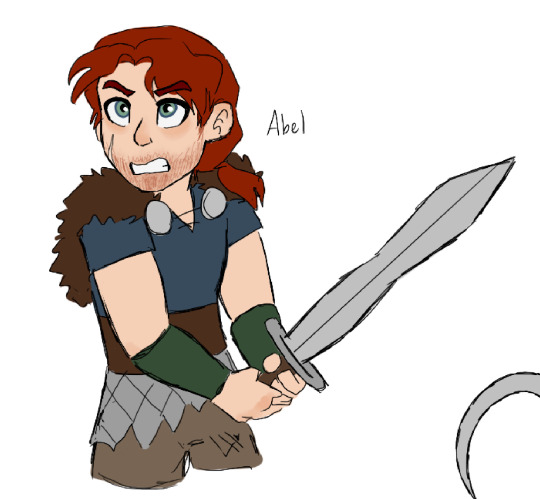

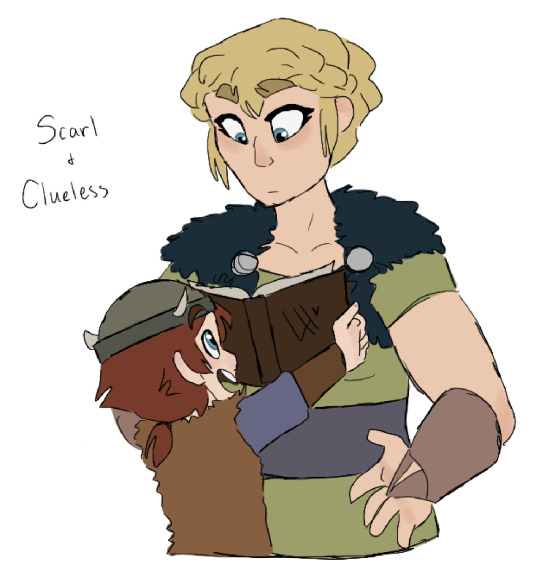

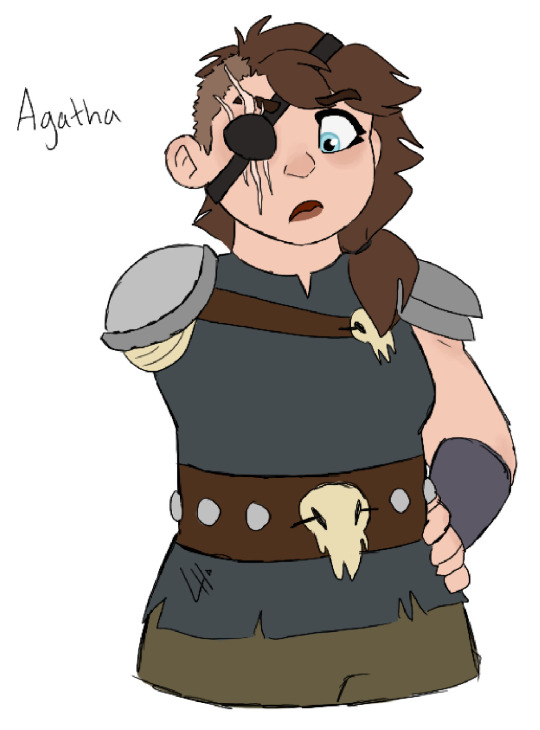
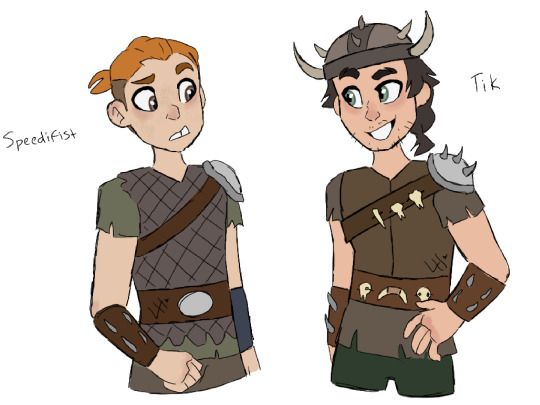
#most of these people are from the Archipelago#scarl and clueless have been mentioned a few times in prior posts but everyone else is new#Laika and Ila don’t show up until much later. more RTTE era#so does Abel. but I’m thinking about having Ingrid pop up earlier than planned#Agatha and Scarl are part of my belief that HTTYD needs more big beefy ladies#so i made big beefy ladies#some of these designs might get tweaked as I draw them more#(specifically Ila. definitely Ila. more so her clothes at least)#but the goal for the supporting cast is to expand on pre-existing tribes beyond the five people at best we meet in the show#i want to expand on other regions and tribes of this world#beyond the few people that we meet from them#people are INVOLVED. they’re not just nameless faces in the background to the main characters stories#the deep 2015#the deep cartoon#httyd#httyd/the deep crossover#httyd oc#the deep oc#Ingrid and Abel are actually the deep OC’s i put into the story#mostly because they’re central to another OC’s story#but this was my first time drawing them#(Ingrid was a nightmare to design lemme tell you)#Abel was embarrassingly easy#i kinda want to draw little doodles of these characters too#just to furhter expand on them and understand them#is there a tag limit on Tumblr? if so I’m sure I’ll be the one to find it I can’t help but ramble in the tags
12 notes
·
View notes
Text
@majikanben replied: bagill, already with a bottle of brandy and two glasses: did someone say drinking?

" Heh, you work quick. There sure has been a lot of talk about drinking...and weddings. Which is far less appealing to me than indulging in a drink or two. "
#[ ☀ ⁱ ᵃᵐ ᵇᵒᵗʰ ʷᵃʳ ᵃⁿᵈ ʷᵒᵐᵃⁿ ;; ⁱᶜ ]#majikanben#she tried the engagement thing once#it didn't end well#plus at least this era of gerudo aren't that keen on marriage really#im sure they have some traditions for those that marry within the tribe#but those that marry outside the tribe are rare#and they usually go by their spouse's traditions in that case#there's less of a middle ground with the gerudo in this era than we see in botw/totk#where it seems like women get married and live outside of Gerudo town#but come back to work? idk it's odd to me and nabs lmao#but they also don't have whole classes and ceremonies for embarking on a whole journey to find husbands and get married so#lots of differences between oot era and botw/totk gerudo
1 note
·
View note
Text
"The U.S. government is entering a new era of collaboration with Native American and Alaska Native leaders in managing public lands and other resources, with top federal officials saying that incorporating more Indigenous knowledge into decision-making can help spur conservation and combat climate change.
Federal emergency managers on Thursday also announced updates to recovery policies to aid tribal communities in the repair or rebuilding of traditional homes or ceremonial buildings after a series of wildfires, floods and other disasters around the country.
With hundreds of tribal leaders gathering in Washington this week for an annual summit, the Biden administration is celebrating nearly 200 new agreements that are designed to boost federal cooperation with tribes nationwide.
The agreements cover everything from fishery restoration projects in Alaska and the Pacific Northwest to management of new national monuments in the Southwestern U.S., seed collection work in Montana and plant restoration in the Great Smoky Mountains.
“The United States manages hundreds of millions of acres of what we call federal public lands. Why wouldn’t we want added capacity, added expertise, millennia of knowledge and understanding of how to manage those lands?” U.S. Interior Assistant Secretary Bryan Newland said during a panel discussion.
The new co-management and co-stewardship agreements announced this week mark a tenfold increase over what had been inked just a year earlier, and officials said more are in the pipeline.
Newland, a citizen of the Bay Mills Indian Community in northern Michigan, said each agreement is unique. He said each arrangement is tailored to a tribe’s needs and capacity for helping to manage public lands — and at the very least assures their presence at the table when decisions are made.
The federal government is not looking to dictate to tribal leaders what a partnership should look like, he said...
The U.S. government controls more than a quarter of the land in the United States, with much of that encompassing the ancestral homelands of federally recognized tribes...
Tribes and advocacy groups have been pushing for arrangements that go beyond the consultation requirements mandated by federal law.
Researchers at the University of Washington and legal experts with the Native American Rights Fund have put together a new clearinghouse on the topic. They point out that public lands now central to the country’s national heritage originated from the dispossession and displacement of Indigenous people and that co-management could present on opportunity for the U.S. to reckon with that complicated legacy...
In an attempt to address complaints about chronic underfunding across Indian Country, President Joe Biden on Wednesday signed an executive order on the first day of the summit that will make it easier for tribes to find and access grants.
Deanne Criswell, administrator of the Federal Emergency Management Agency, told tribal leaders Thursday that her agency [FEMA] began work this year to upgrade its disaster guidance particularly in response to tribal needs.
The Indigenous people of Hawaii have increasingly been under siege from disasters, most recently a devastating fire that killed dozens of people and leveled an entire town. Just last month, another blaze scorched a stretch of irreplaceable rainforest on Oahu.
Tribes in California and Oregon also were forced to seek disaster declarations earlier this year after severe storms resulted in flooding and mudslides...
Criswell said the new guidance includes a pathway for Native American, Alaska Native and Hawaiian communities to request presidential disaster declarations, providing them with access to emergency federal relief funding. [Note: This alone is potentially a huge deal. A presidential disaster declaration unlocks literally millions of dollars in federal aid and does a lot to speed up the response.]
The agency also is now accepting tribal self-certified damage assessments and cost estimates for restoring ceremonial buildings or traditional homes, while not requiring site inspections, maps or other details that might compromise culturally sensitive data."
-via AP, December 7, 2023
#united states#us politics#natural disasters#disaster relief#public lands#land back#indigenous#native american#first nations#indigineous people#sovereignty#president biden#biden administration#hope#good news#land management
596 notes
·
View notes
Text
rotating an AU idea that I like to call "zuko and toph and do terrorism while rookie avatar aang feels like he's getting in over his head already" in which the hundred year war never happened because roku chose not to spare sozin, only to die shortly thereafter. the air nomads continue to thrive, but the air avatar dies of an illness in their childhood.
avatar korra guides the four nations into a time of prosperity, fueled by technological revolutions from the fire nation, agricultural innovations from the earth kingdom, seafaring knowledge from the water tribes, and diplomacy from the air nomads. she dies under mysterious circumstances, followed shortly thereafter by the loss of the earth kingdom and fire nation avatars- so the white lotus has a vested interest in the survival of the young air nomad avatar, Aang.
he grows up with his mentor, monk gyatso- but is also taught the four elements much earlier than previous avatars. he befriends the children of the southern water tribe's chieftain, the daughter of which is taught waterbending alongside him by his masters hama and pakku (who never see eye to eye). when he is fifteen, gyatso decides it would be a good chance for aang to see the world with his friends-
-starting with the newly formed republic city.
(or: it's an era swap without being a true era swap.)
aang is hopeful that his time as the avatar will be as peaceful as korra's was (you know. aside from the 'died under mysterious circumstances' thing). this may be wishful thinking given the recent unrest in the fire nation- mysterious assailants invaded the palace in the dead of night, resulting in the death of fire lord iroh and his heir, prince lu ten, and the disappearance of the young prince zuko.
the case was never closed.
iroh's brother, ozai, ascended to the throne in his place. his reign has been plagued by trouble ever since- in the form of a pair of masked terrorists known collectively as The Blue Spirit. as the Avatar, it's Aang's duty to stop the pair- which is a lot harder than it should be, given that nobody knows who they are.
at least he has the peaceful refuge of the Jasmine Dragon, run by old man Mushi and his nephew, Lee. the heiress of the Beifong family, Toph Beifong, and the princess of the Northern Water Tribe, Yue, are almost always there as well during their breaks from the Republic City Academy for Fine Young Ladies. even the bodyguard the White Lotus sent to Republic City with him opens up and just acts like a normal person while they're at the Jasmine Dragon.
(her name is Suki. she's a Kyoshi Warrior. Aang and Katara are pretty sure Sokka's in love with both her and Yue.)
...now if he could only figure out how The Blue Spirit always manages to have a leg up on them.
#yes. yue participates in the terrorism too. if you're picking up what I put down#she doesn't fight. she's the plan person#since zuko and toph's idea of a plan is 'arrive. break things. leave'#GEE i wonder who was behind the “attempted” coup in the fire nation. surely not ozai. definitely not.#i'm sure he has totally normal plans for the comet that's coming at the end of next summer :)#don't even worry about it#jazz era atla au
71 notes
·
View notes
Text

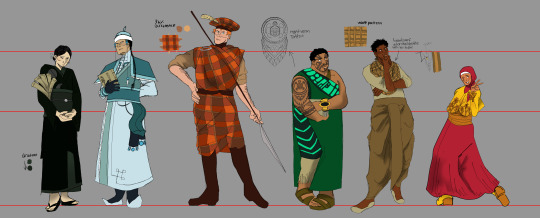
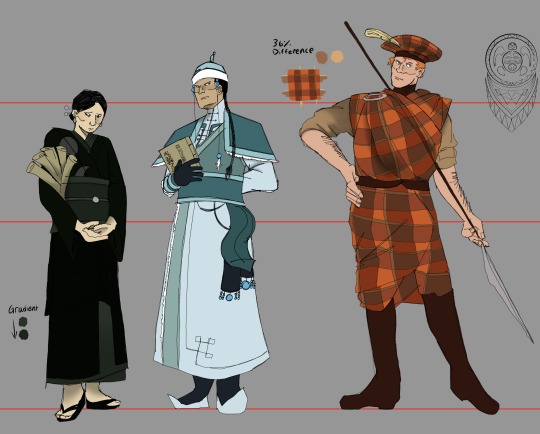


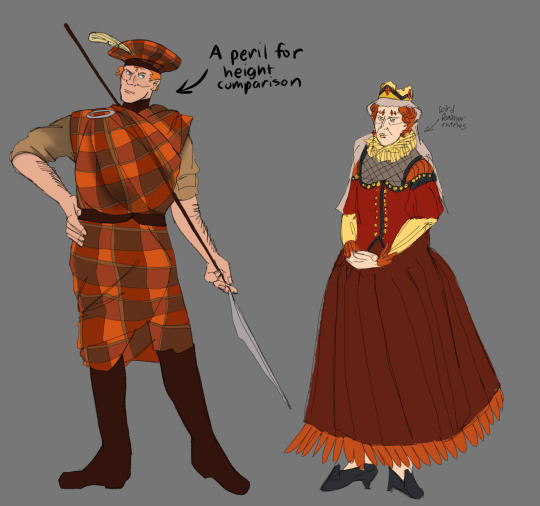



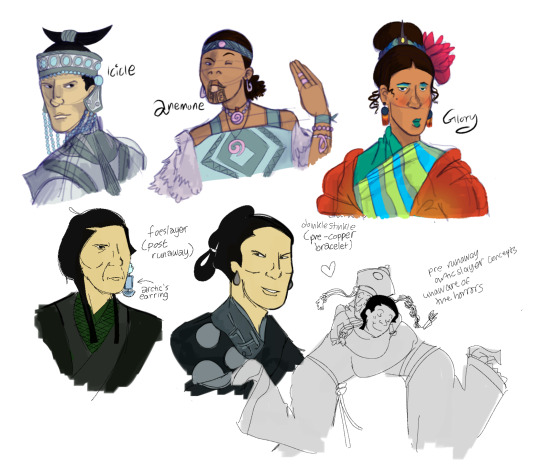
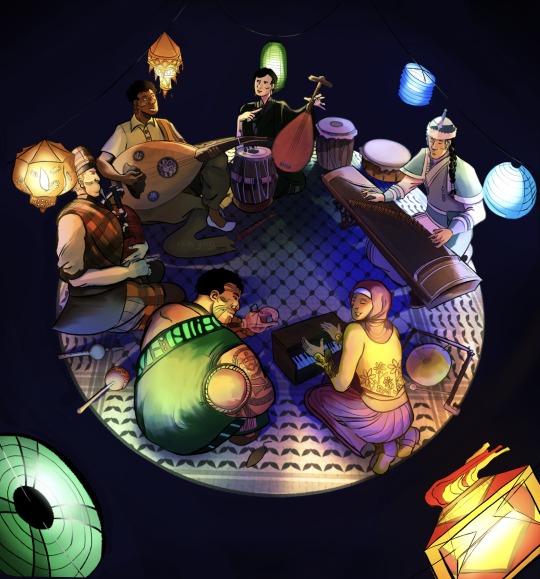
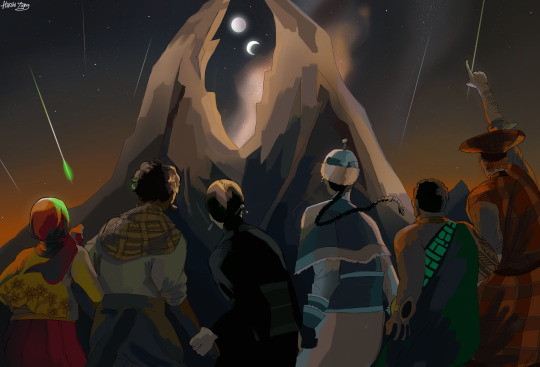

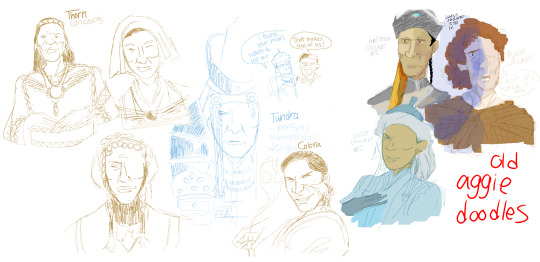


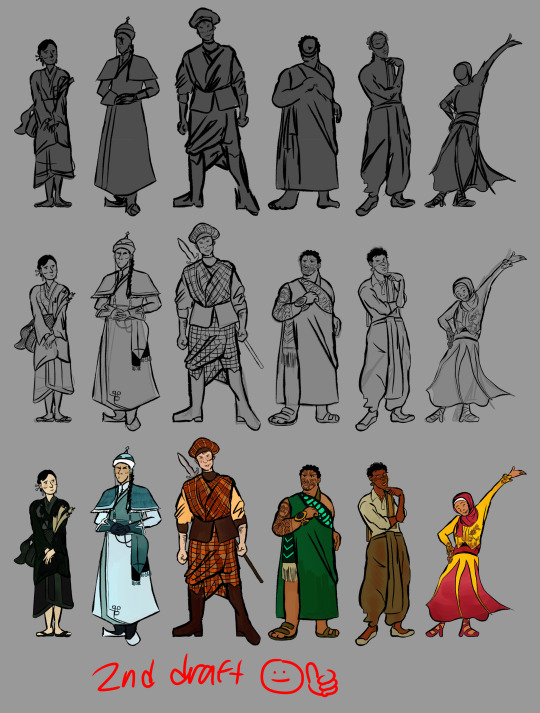
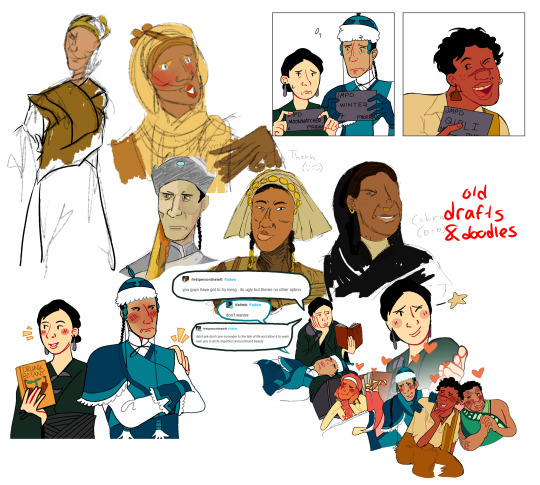
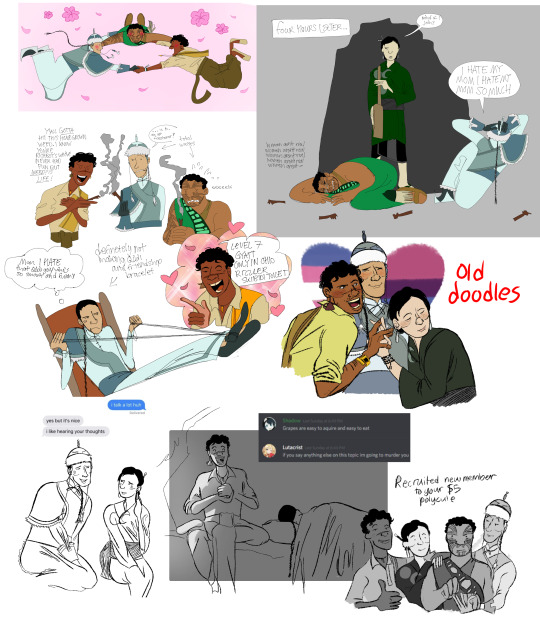


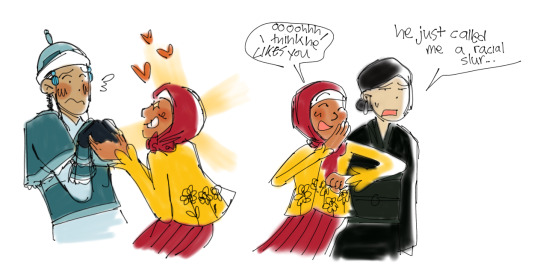
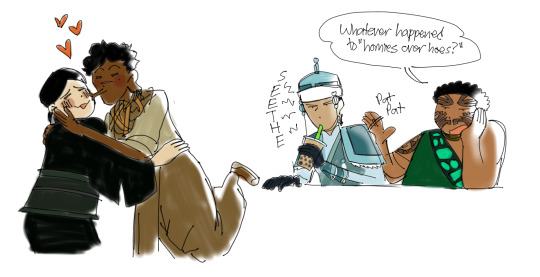
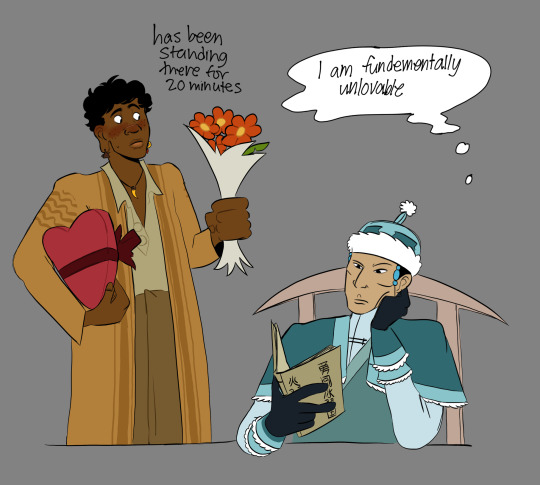
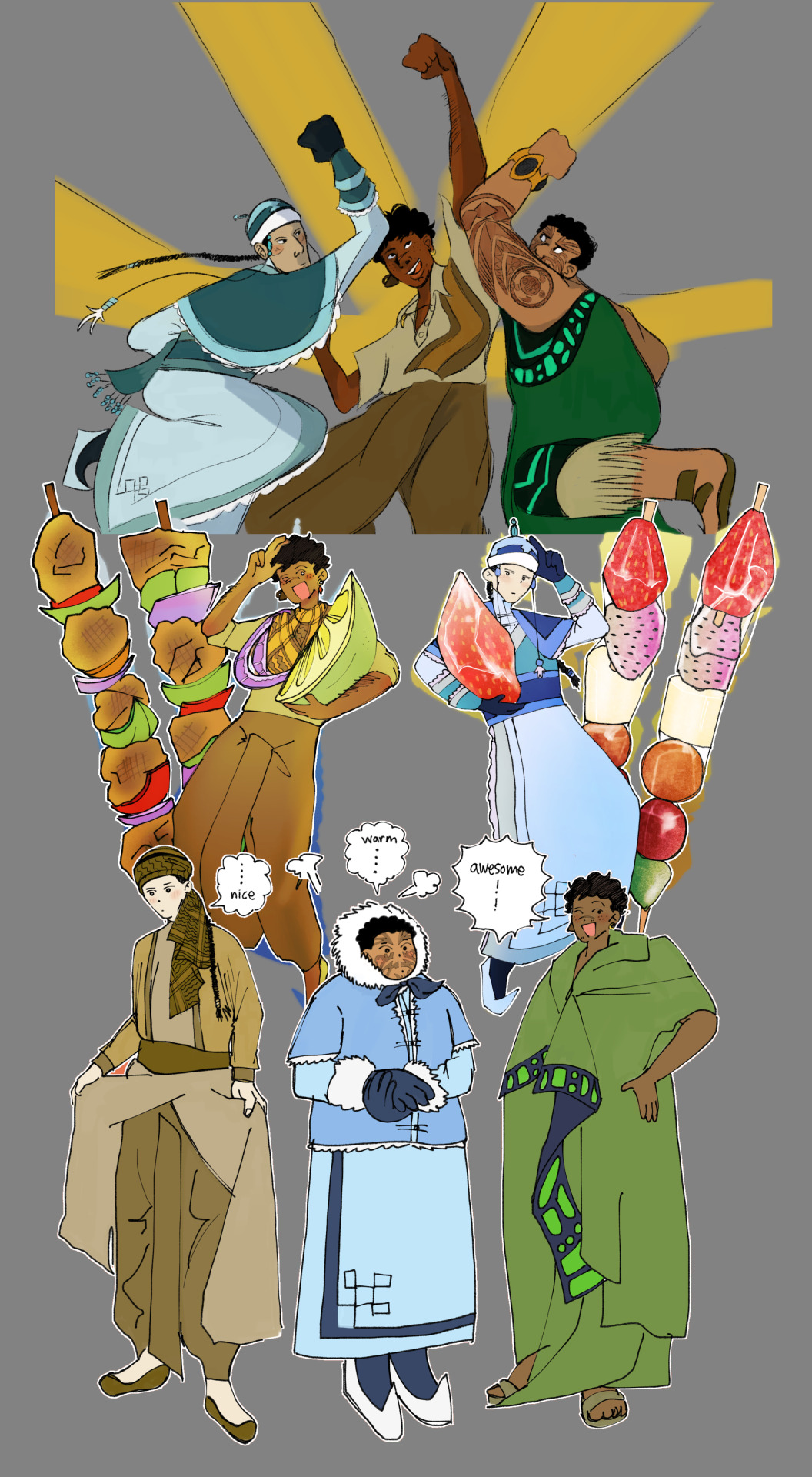

ANOTHER human au art compilation! Here’s the first! More info about the AU and their cultures under cut ~
Groundwork:
-Abilities which stem from things inherent to dragon biology (fire, venom, frostbreath, gills, etc.) aren’t present. More traditionally supernatural gifts (mindreading, oracle, animus magic, etc.) are still present. In retrospect this makes the Nightwings completely op but shhh
-Each tribe is inspired off a mishmash frankenstein of different real-world cultures
-Dragons are an endangered species, just a hum in the background and nearly hunted to extinction. They’re hardly considered a threat, especially when most humans haven’t even seen one in their lives. Once the centre of each people’s culture and civilisation, they’re now nothing more than Bigfoot sightings or exotic pets.
Culture:
-Sandwings are the least homogeneous tribe and take inspiration from various cultures in the Indian subcontinent and Arab nations (most largely India and Palestine). Many subcultures exist within the larger Sandwing kingdom. Common identifies (not present in them all, but there will usually be at least one) include gold accented accessories, darker skin, and clothing with light, desaturated, yellow/orange tones. They’re renowned for their abundance of poison, excellent street food, musical talent, and stereotypically maliciously intelligent. Regardless of class there’s a nation wide pattern (you can find the reference for it by Qibli’s headscarf) symbolising trade routes, oasis waters and dunes. It’s a symbol of national pride (included on thorn’s dress, and ostrich’s headband/headscarf).
-Nightwings are, on the contrary, the most homogeneous tribe due to their small population. They’re based on Japan (spanning multiple eras). I like to think the Nightwings lost a lot of their culture after migrating to the volcano, for they were once the most religious tribe, worshiping the moon alongside the Icewings, which I’ll get to later on their cultural similarities. I promise it’ll make sense. By now, all their deeply religious traditions have been relegated to superstitions. It was said they were blessed by the moons, but the connection has been largely severed. Only old dresses follow the tradition of embroidering in the moons they were born under. Moonwatcher’s dress is something akin to a hand-me-down, as are her silver earrings, it’s by coincidence it lined up with her actual birthday. Moon’s family was an exception because she came from a long line of seers (or alleged seers) who have done their best to preserve a crumbling culture. Common identifiers include near pitch black clothing and skin as pale as the moon.
-Icewings have some of the largest populations, however, are surprisingly homogenous. Most sub-cultural differences are as a result of class. They’re based on Mongolia and Manchuria. Like Nightwings they are also deeply religious, maintaining their beliefs through rigorous scholarship. Hair has intrinsic religious value as a gift from your family- therefore it cannot be cut. The same goes for ear piercings and any other physical alterations to your body. IceWing jewellery as a result is very distinct because of its lack of need for an ear piercing, hooking around the back of the ear instead. Common identifies include long/braided hair, and light, cool-colored clothing suited for the cold.
-Skywings are loosely Scottish inspired, and I do not have a lot to say about the rest of the tribes. Most of their clothing have feathered accents. The peregrine is a sign of luck and wealth, with their feathers being adorned on the upper classes. Geese and chickens, being common farm animals, are found adorned on working classes. The second richest tribe, employing silver, gold, lazuli, and about any gem they can find in their clothing. Common identifies include curly orange/red hair, taller statures, feathered accents, a tartan like pattern, and clothing ranging from yellow to magenta.
-Seawings are loosely based on various Polynesian cultures, most prominently that of the Māori. The sea has an intrinsic religious value to them, with all children learning to swim, sail, and/or fish. They live off the sea’s resources, rarely consulting the surrounding land for supplies. On rare occasions albatross birds and seagulls are plucked for headdresses. These are reserved for high ranked royalty. Their clothing is loose and well adapted for the warm beach setting. Common identifiers of Seawings include ta moko like tattoos, olive skin, and clothing ranging from lime to purple.
-Rainwings are loosely based on Thai, Indonesian, and Cambodian cultures. They’re colourful and have the second largest poison reserves (bested by sandwings). Having once been a trade centred tribe, now they’re isolationist, albeit not intentionally. They have many history records, almost as detailed as that of Icewings, but the art has been lost to a changing cultural atmosphere. Once too religious, now their intrinsically religious practices are more cultural. Their clothing is similar to sandwings in the fact they cover as much of the body as convenient but remain loose and breezy. Common identifiers include bronze tan skin, vibrant pigmented clothing, and flower motifs. Nightwing villages don’t follow that guideline, they build on the ground as a tribe with a focus on hunting. I’m assuming everything in this universe is made proportional to dragons, hence why the trees are so large. This assumption is based off that specific panel of Bandit in the book six graphic novel eating a blueberry as big as his head.
-Mudwings are sooo underdeveloped in my au (following in the steps of Tui herself) but they’re based on southern Chinese and Vietnamese cultures! They live in cities akin to Chinese floating villages, Vietnamese floating markets, and Tulou (architectural style of the Chinese Hakka) made of mud bricks. They're a very agricultural based people. Many of their villages are isolated communities- their emphasis on family extending to their towns. Common identifiers include umber skin, straw conical hats, and practical clothing in shades of brown.
#wof#wings of fire#wof au#wings of fire fanart#wings of fire au#wof art#wof fanart#wof moonwatcher#wof winter#WoF peril#wof turtle#wof qibli#WoF kinkajou#wof scarlet#queen scarlet#wof icicle#wof pyrite#wof sora#wof foeslayer#wof lynx#wof thorn#wof ostrich#WoF cobra#wof glory#WoF anemone#wof darkstalker#darkstalker#hwof#Quotidianish#Quotidianish’S wings of fire
297 notes
·
View notes
Text
I think that 2010s "identity politics" discourse was a necessary pushback against the hegemonic view in the 90s and 2000s that neoliberal "meritocracy" was actually, literally real, but with retrospect, I think that the breakdown of a collective sense of identity into ever-more-finely-grained identity tribes has been a disaster, not least of all for the very subaltern groups that it was meant to liberate.
(I say this as someone who came out during this era and very much framed my transition in these terms)
56 notes
·
View notes
Text
Part 6 Trolls Headcanons/ Theories/ Thoughts/ Ideas
Part1 Part2 Part3 Part4 Part5 Part7 Part8 Part9 Part10
Trolls - having an egg on the way is known as an 'Eggnancy" 😂
BroZone - when the brothers weren't sure how to reconnect, they ended up playing rummy together.
Bruce - has attempted to set up John Dory on a date with Brandy's sister.
Bruce - kept having kids because he and Brandy wanted at least one daughter. When they finally had LaBreezy they decided to stop.
Bruce - learned to surf to get Brandy's attention when they first met. Ended up falling in love with surfing before Brandy fell for him. 😁
Clay - the Putt-Putt Trolls didn't have a sad book club as they had no books! After the reunion Clay was very excited about the vast new collection of books he could get his hands on!
Clay - finds out that he was Poppy's favourite Brozone member when she was little and doesn't he just boast about it any chance he gets!
Clay - for Clay to finally forgive John Dory, JD agreed to perform for the brothers+Poppy and Viva in ONLY the funderdrawers. "Do you feel like you're having 76% more fun yet John? Cause I am!" *Camera snap*
John Dory - he doesn't let it show but his ears are constantly twitching to check for danger, a side effect of living in the wilderness alone for so long.
John Dory - sworn off ever having children.
John Dory - pretty scrappy at self defence, can hold his own when boxing.
Floyd - did a few red carpet appearances during his solo era, he felt very out of place. @ssippingwaterfalls 💕
Floyd - after the Mount Rageous incident he gets a little bit reckless without realizing it. He has an "I just survived death so cliff jumping isn't scary anymore' kinda attitude.
Floyd - can read palms and tarot cards.
Branch - Kismet were the ones that originally got him hooked on ring pops.
Branch - learns phrases in other languages to build relationships with subgenre tribes of Trolls. E.g the K-Pop and Reggaeton Trolls.
Branch - started building the bunker while he was still living in the group home with other Trollings.
Poppy - wishes that Branch would initiate physical contact more often.
Viva - calls the older brothers Mr.Bruce and Mr.JD (Clay told her to)
Rhonda - when she was a baby she was more like a big suitcase than a vehicle.
Bonus
Cooper - is actually smarter and more capable than he let's on (quote from Brooklyn 99, "If people knew how smart I was it would be harder to control them.")
#trolls#dreamworks trolls#trolls band together#trolls branch#trolls clay#trolls movie#trolls brozone#trolls bruce#trolls john dory#broppy#brozone
188 notes
·
View notes
Text
i feel like ppl make jack too evil in post-island fics. like. uhmmmm. did we read the same book? the one with the ugly ginger kid, so desperate for approval that when he doesn’t get it—from ralph, who he so desperately wants to impress, and his peers, who don’t even consider him for the position of chief—he gets angry and violent and lashes out because that’s clearly all he knows? that book?
like. i agree that he probably wouldn’t feel much guilt afterwards. he clearly has no qualms with murder (at least, when it happens towards people he doesn’t like), although he isn’t as bloodthirsty as roger. but i see it more as not understanding what he did wrong/the magnitude of his actions. it was all just a big game, wasn’t it? weren’t they just playing war? that’s what the naval officer and the rest of the outside world thinks, so surely he’s not at fault.
nobody ever punishes him. he never suffers the consequences, so he never learns, so he keeps doing it, rinse and repeat. he expects forgiveness from the boys he brutalized and dragged into his weird murder tribe. even if he were punished for his actions, he probably wouldn’t feel guilt, but just like. the sinking feeling of being caught.
also, if lotf happened in an era more….open to trauma therapy…he probably could’ve ended up, like. normal. traumatized and ill, but normal. it makes me sad. these poor boys
#dare i say he might be almost or even equally as traumatized as ralph but he just processed it violently#?#i HATE jack merridew portrayals they’re always ooc at least imo#either too violent or too…freaky….#worse when they try to make jalph HEALTHY#😦😦😦😦#toxic doomed yaoi jalph#lord of the flies#lotf#jack merridew#character analysis#yap session#professional yapper#JACK MERRIDEW IS A CRYBABY BITCHASS LOSER AND NOBODY PORTRAYS HIM AS SUCH!!!!!!!
64 notes
·
View notes
Text
All past Avatars seem to have at least one fuckup or a regret that one or more of their next lives will have to deal with.
Szeto, quite literally, worked for the Fire Lord of his time. Although his work brought peace and prosperity to the Fire Nation, ending the conflicts that were destroying the islands, it also caused a centralization of the administration that would later allow Fire Lord Zoryu and his descendants to centralize all the power, which would end up leading to Sozin and the Hundred Year War. Since he seemed to prioritize the Fire Nation, he most likely neglected the rest of the world, too, which means that Yangchen had to step up more for international issues.
Yangchen was a highly revered Avatar to the point that she was deified; she helped the nations progress and flourish. However, focusing too much on human matters and always favoring humans, she neglected spirits. That led to Kuruk having to deal with the consequences.
Kuruk, unlike Yangchen, focused too much on Spirit World issues—to the point that it cost him his life and died very young—, seemingly neglecting human issues, causing the Peace of Yangchen's era to deteriorate very quickly. His premature death and apparent neglect led to Kyoshi having to deal with a very unstable world.
Kyoshi managed to stabilize the world during her extremely long life—in contrast to Kuruk's short life—and is remembered as a highly effective and respected Avatar. However, her big mistake and regret was the creation of the Dai Li, which would later help with the Conspiracy of Ba Sing Se, help Azula conquer the city or start kidnapping the new airbenders: overall, give Aang and Korra headaches.
Roku enjoyed relative stability at first after Kyoshi's death, though this didn't last that long; he lived through a industrial revolution and the rise of nationalism in more than one nation. He was a very diplomatic Avatar who managed to stop a war between the Northern Water Tribe and the Earth Kingdom, and became a respected Avatar. However, he was indecisive when it came to stopping his former friend Sozin, which was probably the biggest mistake and regret: it led to the genocide of a whole nation and a war that lasted a hundred years, leaving Aang to deal with it.
Aang ended the Hundred Year War and helped create a new nation where people from everywhere could leave peacefully. However, by letting Yakone live and escape prison, and failing to fully give nonbenders a voice in Republic City, caused Korra a lot of headaches with Amon and the equalists. Furthermore, another one of his biggest regrets was running away before the Air Nomad Genocide (although it was not really his fault, he was a child and an untrained Avatar and had he stayed, he probably wouldn't have been able to avoid it: he would have probably died too or been captured), and his biggest wish was to rebuild the Air Nation one day, which Korra did during her life, making up for what he thought was his biggest mistake.
Korra will probably have one of those mistakes/regrets too, and I really wonder what it'll be. We know it likely won't be neglect of neither spirituality or human issues like Yangchen or Kuruk, since she seems pretty focused on both. So far her biggest regret seems to be losing the ability to make contact with her past lives, so maybe it'll be that? The next Avatar will somehow manage to regain their connection with the rest of the past Avatars? Doesn't seem likely to me but idk. Or maybe more Red Lotus bullshit, since in the show they said that there were probably more members and Korra didn't stop them all? Idk
#avatar the last airbender#the legend of korra#kyoshi novels#avatar szeto#avatar yangchen#avatar kuruk#avatar kyoshi#avatar roku#avatar aang#avatar korra#atla
531 notes
·
View notes
Note
Hey, I noticed that in one of your posts you showed an Iron Age Finnish woman's dress. Would you happen to have a good idea of what Finnish men were wearing in that era? The information on it seems sparse. I do have a relevant book that I'm about to look through, but I'd like to hear your insight too!
Hi! Thanks for the question (and sorry for the slow answer), I do love Finnish Iron Age clothing so it's always my pleasure to write about it. I've been wanting to do a deep dive into this for a long while, so maybe I'll do at some point a post about women's dress too.
Unfortunately no one has good idea of the Finnish Iron Age men's dress (and if you find any book or other source that claims otherwise, do not trust it), since there's much fewer archaeological finds of men's dress than women's dress. The most accepted theory on why the textiles of women's dress survived surprisingly well is because of the bronze ornamentation commonly sewn into especially the fine women's dresses of the era. The bronze protected them from decomposing fully. Presumably men's dresses were not decorated similarly then. There are some finds though and we can piece together at least some kind of vague picture.
I will be discussing the period from Viking Age to Crusade Age in Finland. Viking Age is often defined to cover 800s to mid-1000s and the Finnish Crusade Age started right after the Viking Age and ended in the end of 1200s, where the Finnish Medieval era begins. Crusade Age refers to the period where mostly Swedish (also German) crusaders in the span of couple of centuries conquered lands of the Baltic-Finnic pagans. The crusades of this period targeted pagans all over eastern Baltic Sea, including Baltic-Finnic Karelians, Livonians and Estonians, and Baltic peoples, and the Scandinavia too, where Sámi people were targeted. After that the Finland and Sápmi were colonized by Norse people and stayed that way untill Finland was transferred under Russian rule, but to this day Sápmi still stays under colonial rule, including Finnish colonial rule. The current Finland was very multicultural area, mostly populated by Finno-Ugric peoples, including Sámi people, Karelians and various Finnish peoples.
It's important to understand that even just Finnish peoples where not homogeneous, but had distinct, yet of course strongly related cultures. These were Finns (suomalaiset) (yes most people we now call Finns were not in fact called that) in the coast of southwestern and western Finland, Tavastians (hämäläiset) in central-western lake-Finland and Savonians (savolaiset) in central-eastern lake-Finland. This means we can't mix findings from all over Finland to reconstruct a dress without evidencing that all the elements were actually used in one place. These three tribes had broadly similar base for their clothes, but distinctive jewelry and detailing. The big divide was and has always been between eastern and western Finnish peoples. This is because western Finnish people were in close contact through the sea with Norse people and southern Baltic-Finnic peoples, while eastern Finnish people, Savonians mostly, were influenced a lot by their proximity with Karelians. Another dividing factor was the very different environmental conditions between western and eastern Finland. The Finnish coast especially in west is very flat and fertile land, while the lake area, especially in eastern Finland is very rocky, hilly and quite infertile. The main way it effected clothing differences was that western Finland being more wealthy had more elaborate clothing. Tavastians in both occasions fall quite in between, but they tended to be more in the western cultural camp.
My most important sources are a study by a doctor of cultural anthropology, Jenny Kangasvuo, Savon historia I (Savonian history) digitized and open sourced here and the digitized archeological collection of Finnish Heratage Agency. They are all in Finnish so not very useful for most people unfortunately.
Finnish Men's Dress in Viking and Crusader Ages
The basic garments men wore were broadly similar as women. They wore a shift/shirt, knee or above-knee length dress, cloak, belt, shoes and some kind of headwear. Wool was used most commonly, though the shirt would sometimes be linen too. Even evidence of silk has been found in some western Finland graves. I would assume that would be from a dress of some great man, who traveled to gain riches, possibly with vikings. Embroidery and decoration with metals was a typical feature of the whole Eastern Baltic Sea area. In Finland during this period bronze was the most common decorative metal, but silver was used too. Decorative elements were usually woven with small bronze spirals into all kinds of patterns. Here's examples from the reconstructed Ravattula's dress (Finns) used by women.
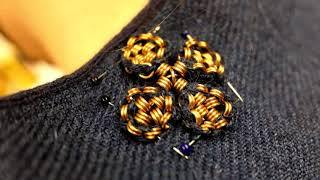
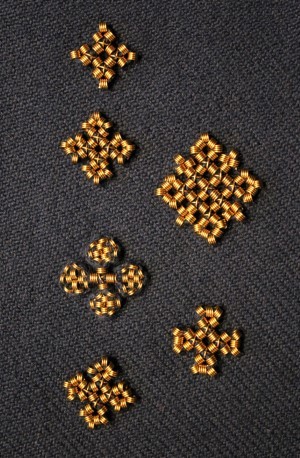
Shirt
The shirt (in Finnish shift of both women and men was called shirt) was basically a long shirt or under dress. We can assume it was similar to those of women's except shorter since the dress men wore was shorter too. They were made from wool or linen, I would assume wool was used in winter and linen in summer, when linen was even available. The neckline had a cut and closed with a bronze brooch. Horseshoe brooch was common. The first one is a quite typical bronze horseshoe brooch with a bit of ornamentation from Salo (Finns). The second one is from Tuukkala, (Savonians), it has exceptional ornate detailing and is uncommonly silver, not bronze. The third picture has two quite uniquely ornamented horseshoe brooches, first from Köyliö (Finns), second from Kurikka (Finns).
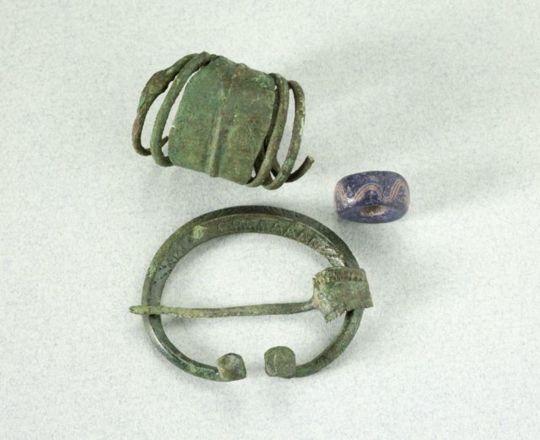
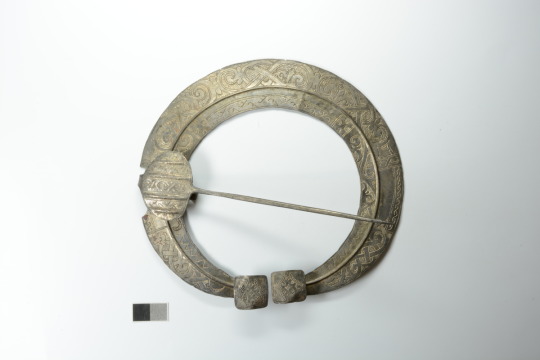
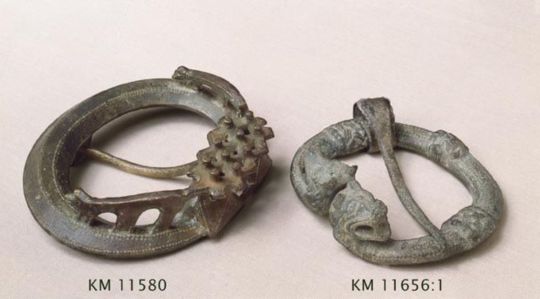
Legwear and footwear
Very little of men's legwear has survived and it's unclear weather men wore pants or separate pant legs, leg wraps or perhaps long socks. Evidence of strings decorated with bronze spirals and tablet woven band has been found in leg area of men's graves. This could mean that they wore either leg wraps, long sock or some sort of pant legs that needed to be secured with string or band under knee. Women used strings and tablet woven tape to secure leg wraps and socks, which I think supports that theory. Sometimes both bronze decorated string and tablet woven band was found in the leg area, which would still be explained by this theory, since it was common to decorate the ends of the bands with bronze decorated strings. Here's an example of sock bands just like that from the earlier mentioned reconstruction of the Ravattula's women's dress. Since men's dress was shorter, I think it would make sense if they still wore some kind of pants or separate pant legs with socks or leg wraps like that.
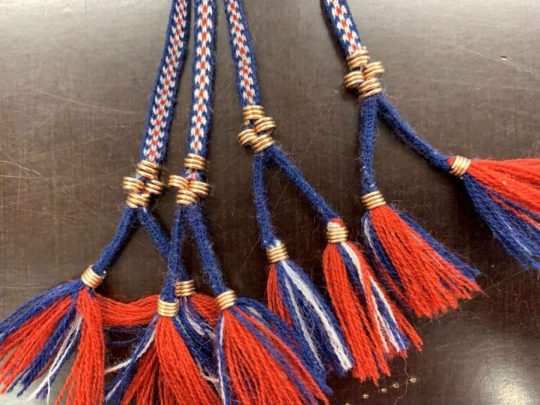
However, the strings and bands could have also been part of the shoes. Everyone probably wore similar shoes - laced leather shoes with a bit of pointed end. They might have been short or ankle length and the lacing was done with either leather cord or tablet woven band, which would also explain the findings. Socks or feet wraps would have been used in them, and straw or wool could be added as filling for warmth. Here's a pair of traditional Izhorian shoes from Estonia from early 1900s, and a pair of traditional Sámi shoes. The designs were likely roughly similar in Viking and Crusader Ages, though obviously more simple, and it's probable that Finnish shoes very something like that too. Here's a 1893 drawing of what findings of shoe material from Korpiselkä (Savonian or Karelian) might have looked like. Considering the quality of archaeology of that time, copious amounts of salt should be applied. And finally as a fourth picture there's reconstruction shoes from Ravattula's dress.


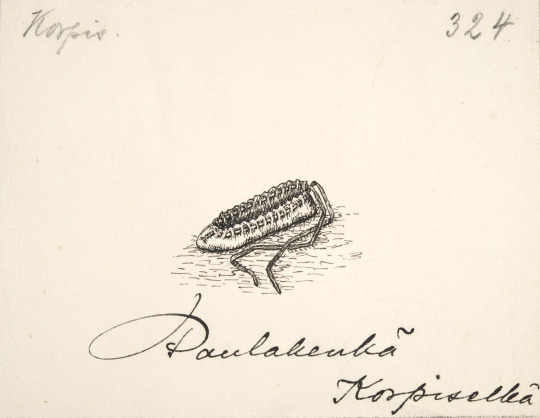
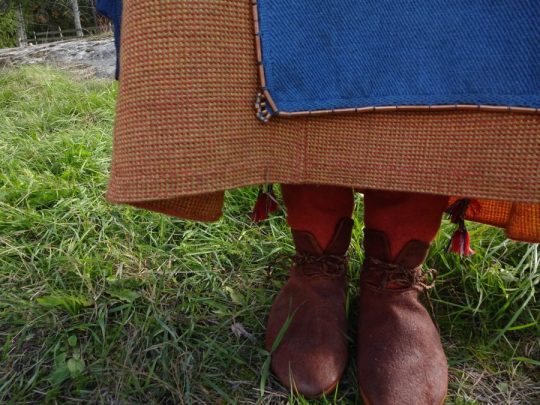
These are not necessarily mutually exclusive theories. The lacing of the shoe could have been laced up the leg and used also to secure either sock or leg wrapping, or they could have been separately secured in ankle and knee respectively.
In some graves twill fabric has been found in the leg area. It could be part of pants or for example leg wrapping, which was often made of twill. One theory about pants is that they were similar as some findings in Sweden, where fairly tight pants made of twill were secured at the hem with buttons similar to cuff studs. These kinds of cuff stud buttons are quite a common find in Finland and some have been found in men's graves close to legs.
Dress
Again there's not much findings of dresses, but a little more perhaps. It was usually from wool. The shape was either a tunic or an open coat. In Karelia there's findings of men's dress suggesting tunics thicker than women's dresses and made from sarka, a type of broadcloth. On the other hand, in Masku (Finns) they found buttons in a row on top of the torso, which suggest a coat closed with buttons. The first picture is a drawing of the grave find. Similary coak closing amounts of buttons have also been found in other places in western Finland. This suggests that Finns and probably Tavastians too wore long coats buttoned to the waist and Savonians wore tunic of Karelian influence. Below there's couple of version of what might this western Finnish men's coat dress could've looked like. The first is an imagined version of the coat based on the Masku grave finds, second is just as imagined version based on Eura (also Finns) grave finds.
Take these "reconstructions" with a strong dose of salt. These are more artistic reconstructions than scientific, since there's not enough material and too much guesswork needs to be done. And because we can see in the Masku grave drawing right here that the other deceased has a large buckle to (probably) close the shirt (to be fair, it could for a cloak too), like was typical, I find it implausible that the coat neckline would be small and round covering the buckle. If you make a decorated big buckle, I assume you want to show it. I would find a v-neckline more probable. It's also easier to make without wasting expensive fabric.
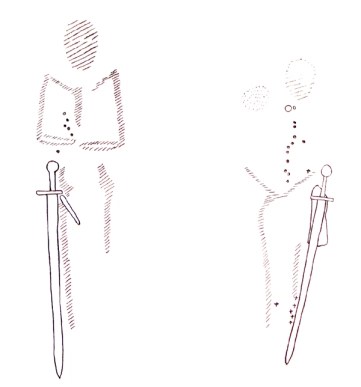
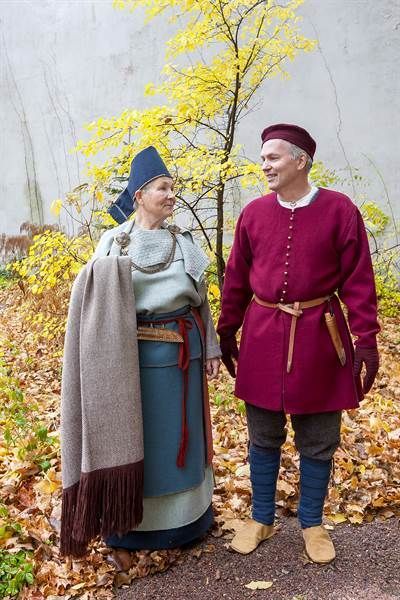
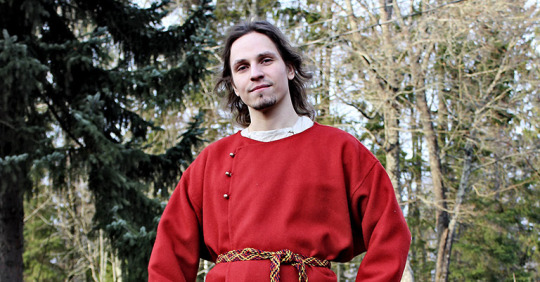
The buttons are interesting. There were what you would imagine - your typical buttons made of bronze like seen in the first artifact from Hattula (Tavastians). But then there was silver jingle bells used as buttons, found for example in both Masku and Eura graves, Eura findings pictured below.
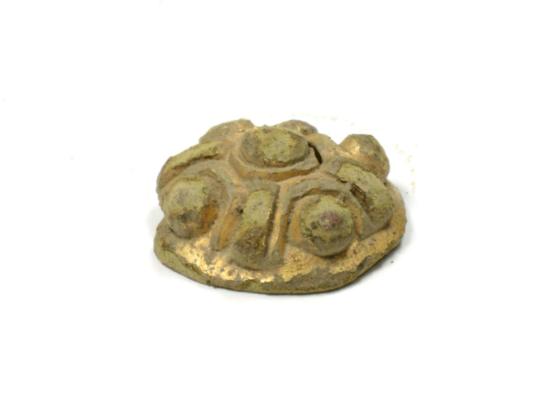
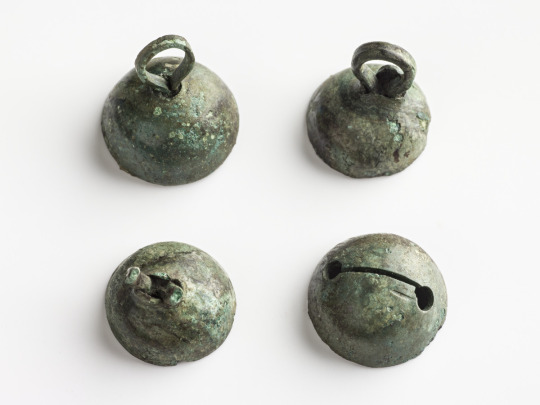
It's possible, even probable I'd say, that the hemlines of men's dresses were finished with tablet weaving patterns, like women's dresses. Also I would assume the pattern of the men's dress (and shirt) was mostly similar to the women's underdress/shirt patterns. So here's couple of different reconstruction patterns for women's dress. Different historians have made different interpretations of the patterns, so it's very much undecided what it really was like.
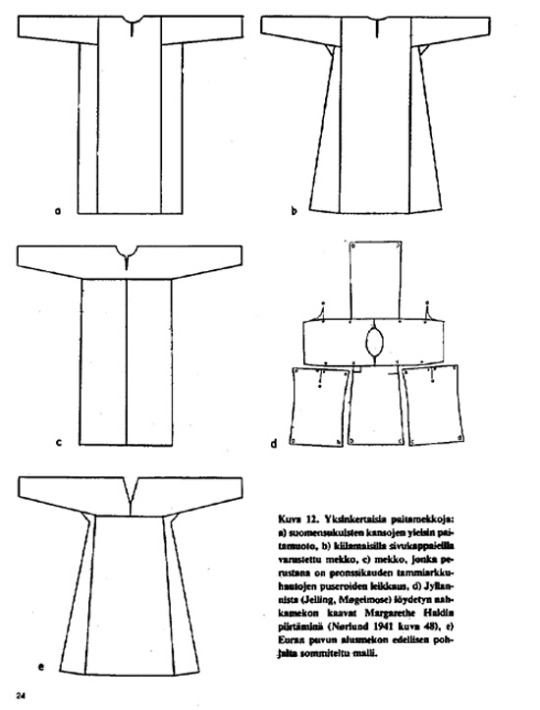
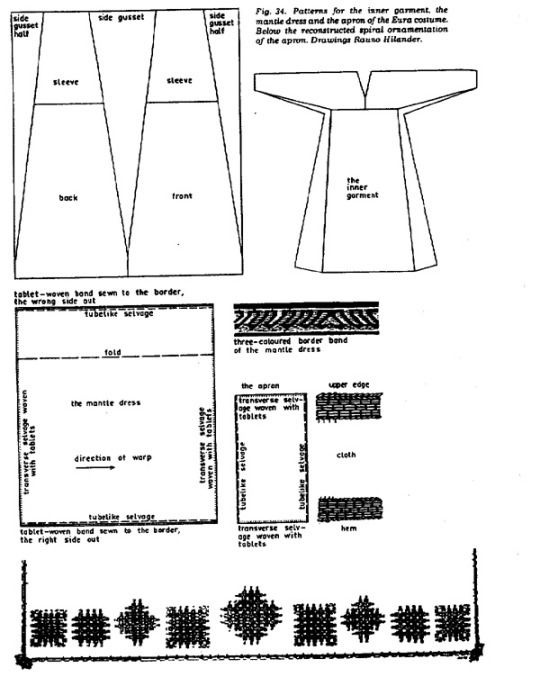
Belt
This is likely the most ornamental part of men's dress. They could be made out of leather or tablet woven band. And there's another east-west cultural divide here. Karelian belts were made out of leather, were usually 1,5-2,5 cm wide, decorated with iron or bronze studs and had a buckle made out of iron or bronze. These types of belts have been found in Savonia too, for example in Tuukkala grave find, which you can find very cool pictures of in this photo documentation of the dig in pages 173-175. In western Finland a "hela" belt was the common style. I don't think there's a world for hela in English. It's a sort of decorative lamella, small metallic plate (not necessarily square but often so) attached to fabric or leather with studs or sewing. Hela belt came from the Permians of Kama river, who were one of the many Finno-Ugric peoples who used to populate much of European side of Russia. Karelians lived closer to Permians, so you might think Permians would influence eastern Finland more, but my theory is that the costal Finns, who frequently joined viking crews and at least were in close contact with merchants including vikings, who would travel along the eastern route through the eastern European rivers, where they could go all the way to Kama river or at least meet traveling Permians. Here's yet another Finnish source more on the Finno-Ugric people around Kama river.
Anyway, hela belt was made of leather and filled with small decorated lamellas, often in square shape, but various other shapes too, like animal ornamentation. In this period hela belt helas were bronze. First image is a nice full set of hela belt metal pieces found in Pirkanmaa (Finns). Second is an older example, right before Viking Era, from Vaasa, costal settlement, (Finns), depicting a very Permian style. The third one is a lion hela found separately in Pälkäne (Tavastians). They are also found in Tuukkala, showing that both eastern and western cultural influences were present there at the same time.

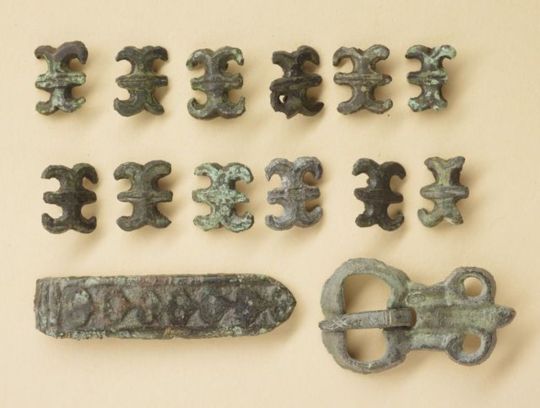
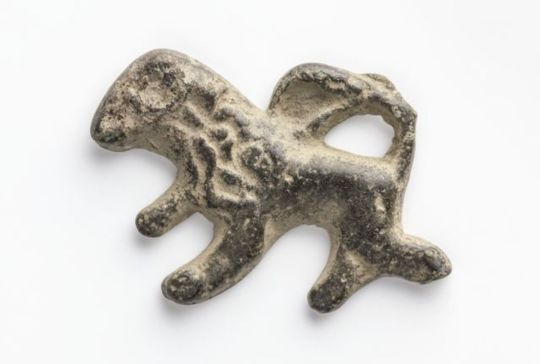
Another western Finnish belt type for men had intricate tassels decorated with bronze spirals hanging on the waist at the end of the belt. They could be made out of leather or tablet woven band. First image depicts a reconstruction of such tassel. Belts in east and west would have strap dividers to hang straps for things like purse, knife and sword. The first picture above has couple of those, but the second picture below has two more of them in more detail in the middle of the picture. These finds are from Lieto (Finns).
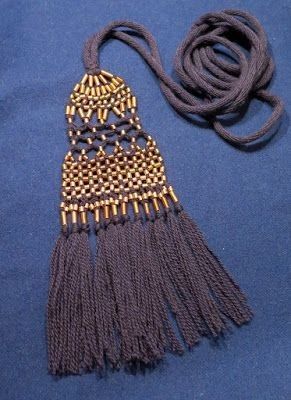

Cloak
Like women's cloak, men's cloak was woolen and either a square or trapezoid. Cloak is yet another east-west divide. In western Finland men's cloaks have embroidery with bronze spirals. They in fact appeared earlier in men's cloaks (in 900s) than in women's cloaks (1100s). They were also a little different in men's cloaks. The spirals and the patterns themselves were bigger and the fastening thread itself was also used for the pattern creation, unlike in women's dresses, where the thread was mostly covered. In eastern Finland there has been no finds of bronze decorations in men's cloaks, mostly only cloak brooches have been left of them. Unsurprisinly same applies to Karelia. This also means there's very little fabric left too. There's one exception. In Tuukkala (Savonians) they found a piece of fabric probably from men's cloak, though it could be from a men's dress too. It was striped, with possibly white or brown base and wide stripes of red, blue and yellow. So perhaps eastern Finnish cloak was not non-decorated, but the decoration was in the fabric pattern. Unfortunately it's hard to know how common fabric like that was, when so little of it is left.
Accessories
It's safe to assume men too wore some type of headwear, but none of those has survived. It probably means it was entirely made out of fabric whatever it was. Some type of hat or cap was certainly used in cold weather at the very least. Tablet woven headband was also possible option for not too cold weather.
In Tuukkala there was couple of interesting jewelry finds too. Two graves had a necklace type mostly found in Karelia. It was birchbark tape covered with nettle fabric and had square helas sewn into it. There were also more typical Finnish necklaces made of beads and bronze spirals.
Razors have also been found with men in their burials, so we can assume shaven faces or at least trimmed beards and moustaces were fashionable.
#dress history#historical fashion#historical clothing#fashion history#history#iron age dress#finnish iron age dress#finnish history#archaeology#answers#anon
224 notes
·
View notes
Text
Y'ALL I had the most wretched train of thought
(spoilers for totk; also I haven’t fought Ganondorf yet so no spoilers in the notes pls!)
The Zonai existed during Skyward Sword, even predating the game. The people of Skyloft and the Zonai have had a few run-ins, some peaceful and others not. At one point, prior to improving their technology, the Zonai tried to steal loftwings to better travel to different sky islands. Least to say, Skyloftians did not like that. They have an uneasy peace and keep their distance far from each other by the time of Skyward Sword, but Link and Zelda are familiar with their existence.
When the cloud barrier disappears, it allows the Zonai to go back to the Surface as much as it does the Skyloftians. It takes them a few years to manage it and establish a settlement, and they eventually run back into the Skyloftians on the Surface. Link and Zelda are married with kids by now, and Zelda is the leader of the Hylian settlement. The Zonai discover that Link is responsible for the cloud barrier's disappearance (Zelda is proud of Link for defeating Demise so she'll let him take all the credit; also, she doesn't need nor want to tell a ton of people she's a goddess reincarnate, especially to a tribe her people have historically not had the best relationship with).
In thanks, the Zonai give Link a gift: a Secret Stone.
The Zonai tell Link that this special magical stone is one of several that are gifts from the goddesses. The Zonai do not know all their properties, only that they enhance whatever abilities the user has. Link figures this will enhance his fighting prowess, and though he is appreciative of the gift, he doesn't think it'll make much of a difference to him.
And then the nightmares come.
Link starts getting nightmares of varying scenarios. A knight fighting a giant monster, facing down an army of mechanical beasts. A child struck down by a demon king. A man with a fairy fighting a demonic beast. Link sees his children, he sees what Hyrule grows to, he sees Demise come again and again, and he sees the Heroes who have to fight him.
Demise's dying words weren't a hateful monologue spat out in spite. They were a promise, a curse.
With this knowledge, Link goes to Zelda, and the two try everything they can to figure out how to stop this. The visions drive Link to near insanity, preventing him from gettin more than one to two hours of sleep for weeks. Zelda goes to the Zonai to ask more about the Secret Stones (she wants to give it back, honestly, but is afraid that it would be viewed as a rejection of the gift, and given the history of conflict between their tribes, she doesn't want to go that route). The Zonai know very little of the stones, though, and Zelda doesn't get much. Link, on the other hand, learns about them from the dragon servants of Hylia. He is told that the stone, when combined with its user, can make the wielder immortal.
Link doesn't care about immortality. But he does care about stopping the demon king, in every era, in every place, in every time. He does care about protecting his descendants, his people, the whole world.
The dragons warn him that he will never be the same, that he may never actually be able to interact with his family again.
After months of haunting visions of destruction and death and pain, he finds himself willing to make that sacrifice. If it means he can protect Zelda and his children, he'll do it.
So one night, he flies on his loftwing to an island in the sky. He hugs his loftwing and kisses him goodbye. He begs his companion to look after his family. Zelda's loftwing arrives, alone. The two birds fly in circles around Link, stirring up a wind as he stares at the Secret Stone held delicately between his index finger and thumb, held just above eye level before he squeezes it in his palm.
And he swallows it.
On the Surface, Zelda drops the glass she's holding. In the sky, a dragon screams.
The Zonai learn what happens when one consumes a Secret Stone.
And the Spirit Dragon is born.
#this is what happens when I listen to dramatic music#while thinking about Breath of the Sky#and therefore thinking about Skyward Sword Link#and him intermingling with botw/totk lore and stuff#tears of the kingdom spoilers#totk spoilers#I suppose after several generations is when Sonia and Rauru get together#Zelda learns about draconification because of her ancient ancestor#Whenever the Hero is born the Spirit Dragon appears and sheds a single tear#skyward sword#skyward sword link#ss link#legend of zelda
189 notes
·
View notes
Text
Been thinking about Astarion and his disapprovals when you help people. I think that yes, it's partly about envy that no-one was there to help him, but also about choice and control. (BG3 is always a game about autonomy, after all.)
So hear me out: back in the pre-turn days, Astarion was a magistrate. And if Baldur's Gate is anything like our medieval and Renaissance eras? He would've had to sign off on some pretty damn awful punishments. (Look at how he talks in the Justice test about how one has to punish thieves, and the Early Access bit where he talks about how killing Arabella would be too harsh for her stealing... they should've cut off her hand instead, the "proper" punishment for thieves and what he would've sentenced her to. He handed down an edict bad enough on a Gur tribe that he was essentially murdered in revenge.)
So how do you justify this to yourself? Well. He had money, societal power, and pretty privilege - this is almost certainly why Cazador chose him, too - and was kind of crap at empathy. And we know he likes seeing people get their comeuppance, likes seeing them taken down a peg. So he carefully ignores all the ways he's been lucky, all his privilege, and pretends he got there all by himself. He goes, "They had a choice. There's always a choice. They weren't helpless. They should have got a job, not begged, or stolen. They earned this. They brought it upon themselves. I'm simply serving them the consequences. Don't look at me like that." (I think this also ties into that later-retconned part about him giving prisoners to vampires. They're just criminals, after all, the same way the Gur are cutthroats and goblins are trash. They chose this life. They chose not to matter.)
So then he falls painfully from privilege, and gets the full horrible buffet of helplessness at Cazador's hands. He "resisted least" - see, surely there's a way to be punished less if you just do the right things, if you say the right things. The spawn who resist are doing it wrong. They made their choice. (He ignores that he's never the favoured spawn, ignores the pliers coming out again, and tells himself this.) If he can say that, he can pretend he still has control - and he so desperately wants control. His old self-justification has been turned up to eleven by the trauma of Cazador.
And suddenly... tadpole. He's free. He's also, as said, traumatised. He tells himself he's never going back to Cazador - look, Cazador can't compel him, look, he can walk in the sun, look, he's seducing Tav. He knows what he's doing! He's in control! The tadpole just being luck? He can't afford to think about that. Luck can change. Which means Cazador, and everything else, no matter what Astarion does or prepares or succeeds at, can happen again. He's helpless. But no. No. He's not some helpless damsel in distress - his first meeting with you was mocking the very thought!
But look. These people are showcasing their helplessness, almost proudly. And it's horrifying. And they keep saying familiar things - they're saying things he's said, in his more vulnerable moments. And Tav keeps saying things like, "They had no choice - we have to help them." But of course these people did. They got themselves into this situation, they can damn well help themselves out of it.
Because if they didn't have a choice... then neither did all the poor bastards he sent to their deaths or horrendous punishments over the years. Neither did those he brought to Cazador. Neither will all the spawn he's going to sacrifice in the ritual. Neither did he. All that separates them from him is luck, and luck can change. He's not in control. The thought is horrifying, so he pushes back against it. "They're weak, pathetic [...] We are better." Even as he approves of getting Wyll out of the pact and getting Mayrina away from the hag, even as he wants Lae'zel to "break her chains", because he feels a kinship with them. Even as, in a rawer moment, he tells the story about being locked in a crypt and tells Tav not to judge him for what he had to do for Cazador. If he stops to examine that too much, he'll panic. Cognitive dissonance is a hell of a drug. So move on, keep desperately snobbing.
He keeps trying that even when Tav meets his siblings and treats them with empathy (empathy that confuses and horrifies him). "They lured thousands to their deaths," he tells Tav. "I doubt Baldur's Gate will miss them." Or him. If they had control, he had control too. Life before turning taught him that if you're punished for what you've done, with cruelty or with death in a ritual, the punishment implies you still had a choice. He vacillates wildly between victim-blaming and talking about them as helpless unfortunate sacrifices while he tries to get his head round this. Even while, as Tav insists on saying, all that separates him from them is a tadpole. His victims are "criminals and brothel-goers," he tries desperately to tell Tav later - look, they deserved it!
The breakthrough is when he finally admits that the spawn are "the innocent, idiots, and the unlucky." Just like the others whose chains you've helped break, through the acts (his approval slowly starting to turn round on some of them, as this realisation creeps up on him and gains speed). Just like him - he was unlucky. (Which means he didn't deserve two hundred years of enslaved misery, and the people on this journey didn't deserve what happened to them, either. Which means he deserves to be treated with kindness, and so do others.) He can turn from that, and keep desperately scrabbling for control with the ritual (he can command others! He'll "never have to be afraid of anyone, ever again"), or he can stay a spawn, and accept that.
The kind of control he wants is an illusion. You can never truly control others without losing yourself in the process. All you can do to change people is decide whether to help - to reach out and hope they reach back. He's seen this time and time again with Tav, saw it even before he woke up in the ground. It's just that finally, he's stopped outrunning the thought and accepted it. Sometimes he still backslides, sometimes he still sees those who hurt him in the ones Tav wants to help, sometimes he's still rather an arse... but he's starting to see it now.
#Astarion#astarion ancunin#baldur's gate 3#Meta#There's a lot of headcanon in here too but eh#ie me rambling
115 notes
·
View notes
Note
Ngl… I wished the books explored religion more. In the sense of exploring the Great Ice dragon (what is it? What’s its deal… is it a godlike entity? A hero whose name was lost to time?), the Skywing reincarnation belief, the moons obviously have an important role in all of the tribes somehow (specially the nightwings)
I know it won’t happen. But I like to think the dragons of Pyrrhia and Pantala(*) are polytheistic, meaning they believe in multiple deities instead of just the one. Sure each tribe has its own interpretation of the myths and theologies but overall they’re the same. And the SandWing succession war just muddied things and could server as an example why it’s “lost” or at least not as believed as much.
Maybe I’m just a sucker for fictional religions but? There’s so much opportunity I thinks, and with the tribes entering an era of peace an age of sharing culture and theology stories can happen.
.
120 notes
·
View notes
Text
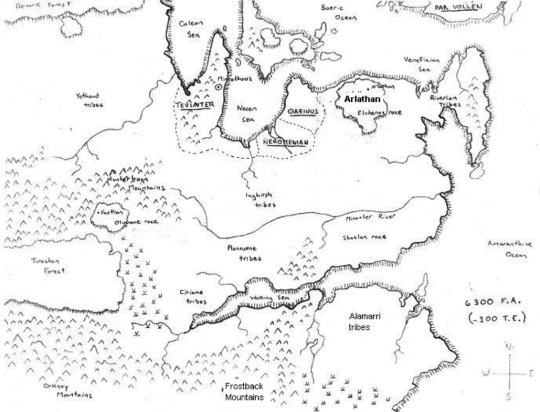
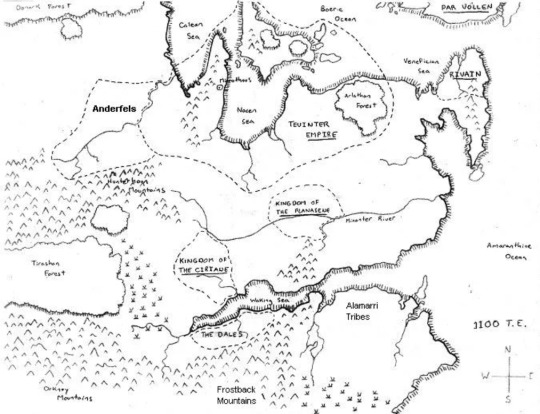
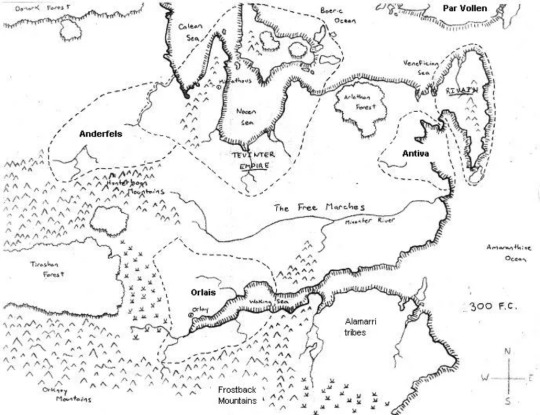


Image credits: David Gaider [source link below]
Article: 'Who is qualified to make a world? In search of the magic of maps'
"You're travelling with your imagination..."
An extensive feature article about maps, map creation and world-building. It refers to David Gaider and the team's early world-building and early-days process of creating the universe that would become Dragon Age. It includes this early series of original sketches of the map of Thedas through time that Gaider drew when the world was being created.
Excerpts under the cut (due to length):
"Dragon Age. That's the game Gaider was working on - or rather, it was the world he would dream up. Ideas had been swirling about what Dragon Age would be for a few months. The team knew it would be like D&D but would not be actual D&D, because BioWare was sick of licensed games at the time. They knew they were going for Tolkien rather than Conan or Diablo. "We definitely had at least some idea of the kind of RPG this was going to be," Gaider tells me when in a video call. But BioWare didn't have a world. One day, Gaider was handed a historical atlas of Europe and tasked with going away and coming up with a fantasy world for players to explore. And almost immediately, he sketched a map." - "What is it about a map that gives it magical powers to bind us and pull us in? I wanted to know more, and through talking to David Gaider and learning about his creation of the map for Dragon Age, I hoped I might find out." - "In fact, he corrects me, "I sketched a lot of maps." But they were the same map, replicated over and over, because in order for a world to make sense to Gaider, it needed history. "I drew this coastline and then made a bunch of photocopies of it," he says, "and did this series of sketches, like, 'Okay in this era, this is where people lived and where they migrated and created different cultures,' and those cultures changed over time as they got conquered. Much like the book of European maps I had, I was doing it in eras and forming an idea in my mind about how these groups all mingled together. David Gaider was kind enough to share his original sketches of the Dragon Age world with me, and in them, you can see an emerging flow of history. You can see the spread of the Tevinter Empire as the race of Men lands in the north and then begins to spread out. You can see, in the earliest images, there's still a kingdom of Elves in the forest of Arlathan, nearby. Then, they are forced out by the growing Tevinter Empire, south to the Dales, where we encounter them in the Dragon Age games, subjugated to being a kind of slave race. Tribes give way to kingdoms, and names we're familiar with begin to appear." - Caption on the sketches: "David Gaider's original sketches of the Dragon Age world. Wherever you see a name typed in, it's because it was changed by EA's in-house sensitivity team, which cross-checked place names with real-world names in case there was a clash. The area of Antiva, for example, used to be called Calabria, but Calabria is the name of a region in southern Italy. "Well, if you do something with the Calabrians that real Calabrians don't like, they might get upset," the sensitivity department at EA told Gaider. "So I was like, 'Oh fine, I'll change it,'" he says." - ""My feeling on history when it comes to worlds," Gaider says, "is that you need to have a lot of it." Without it, he says a world will feel like a facade. "Sometimes you'll see worlds where they've made only what is needed for their current story, and it's like an old Western set: it feels right, it looks right, but then you slowly get a sense of, 'Oh, there's nothing behind those doors.' Before he sat down to draw, Gaider already knew some of the geographical elements he wanted. He knew he wanted a topsy-turvy 'South was cold and North was hot' idea for the continent, to play with people's expectations, and he knew he wanted a large waterway - that he likens to the Mediterranean - carving its way far inland. Today, we know this as the Waking Sea, and it's an incredibly important feature in the Dragon Age games. Gaider also knew he wanted islands far up in the north, from which an unknown race could invade. "I knew that I wanted an 'other' race that would come along," he says, "which ended up being the Qunari." Gaider also knew he wanted untouched areas for adventure, like forests and mountains, just in case the game would need them. "I didn't want every place to be so civilised that when it came time for 'we need ruins' or 'we need massive wilderness', we've got nowhere to go because I've civilised the entire thing," he says."
"Because remember, the team didn't yet know where the game they were making would be set. That's why so much of the continent you see in the sketches is as yet unused in Dragon Age games - the series hasn't needed all of it by this point. Continents are vast, after all, and realising them in 3D for players to explore is a mighty task. "I guess in my head," Gaider says, "we would be probably either on the north of Ferelden, on what became the Free Marches, or maybe off in the west more towards the Tirashan Forest or the Hunterhorns. That was a very wild area and I was like, 'That's a good place for an adventure to be.' Atlas at hand, photocopies in front of him, Gaider set about his work of growing a game world from a bunch of maps, and with not a small amount of trepidation. There was a lot riding on the world after all; it was a far cry from the worlds he'd created and freely abandoned as a teenager. "This is going to form the foundation, ideally, for a lot of games," he says, "and a lot of people are going to do work [on it]. And the trepidation is like, 'I don't know what I'm doing.' I'm essentially the equivalent of a 13-year-old just going, 'La la la, I'm going to call this Ferelden!'" - "Some things bother David Gaider about the Dragon Age 1 map, still, and they occurred when artists prettied his sketches without his involvement. "Oh," he said awkwardly when they were presented to him. "I didn't want it to look like this, exactly." He says they added a lot more rivers and mountains, and flipping between his sketches and the Dragon Age: Origins map, you can see some have moved around, or gained prominence, and places like Redcliffe have shifted. Apparently people would take to the BioWare forums after the game came out to complain about the map's geography. "And I'm like, 'You know what? You got a point,'" Gaider says. This is mostly anger at himself, though, for not doing more about it. Similarly, he wishes he'd been able to sit down with artists and work out what the rest of the continent you don't see in his sketches looked like, so they didn't have to have "the continent just keeps going..."-like messages at the edge of it. "But to where?" Gaider says. But it speaks to something he's noticed in his decades working in games about artists and writers. "They really speak two different languages," he tells me. They process things differently and they tend to care about different things. There were reams of history and lore written in a "world bible" for the Dragon Age team, but getting artists to read it was another matter. They wanted clear visual cues, not piles of backstory. Dragon Age: Origins eventually found its setting in Ferelden, the kingdom in the bottom right bulge of the sketches, so it left a huge portion of the sketched world unused, which the team presumed no one would ever see. "We thought that was going to be the only one," he says of Dragon Age: Origins. "That's why when you get to the end of Origins, there's so many epilogues that cast off far into the future, which, if we'd known that we were going to keep going and keep going with history, we wouldn't have said, 'Oh, in fifty and one hundred years, this is going to happen.' I think we would have played our cards a little closer to our chest. EA apparently found the game very old-fashioned and thought no one wanted turn-based role-playing games like that any more, which of course now seems ridiculous given the success of Baldur's Gate 3. "Baldur's Gate just goes to show how wrong people are when it comes to industry wisdom," Gaider says."
-
"Nevertheless, when Dragon Age 2 eventually was green-lit, the scope of it, and the focus of it, would completely change. With it, BioWare and EA would push towards a console RPG experience that stopped and started less, and had more action-packed combat. And EA only gave BioWare 18 months to make it, so BioWare decided to make a much smaller, more tightly focused game. It seemed like a good idea at the time. "People at BioWare convinced themselves that the fans would be okay - it'll be fine if it's a smaller game," Gaider says. "And I don't know why we thought that was the case, but for a moment there in time, we were like, 'Yeah, sure, it'll be fine.'" As for the mapping, a tighter focus meant centering on one place rather than a whole region, so the city of Kirkwall on the Waking Sea became the heart of the game, and BioWare developed a time-jumping idea for the game so you could see it at various different points in your character's lifetime, which I still think is really neat. And because there wasn't a large region to explore, the game didn't need a sprawling map, so BioWare turned the map on its side to give Kirkwall some height and majesty instead. It wasn't particularly memorable, but it looked nice. The game didn't go down well. "Its highs were really high, and its lows were really low," Gaider says now. "It was very unpolished. If it even got six months more polish, I think the reception would have been a lot different." More importantly, it meant everything would need to change again for Dragon Age 3." - "In Dragon Age: Inquisition, the third game in the series, the map plays a starring role. It's built into the game world specifically so you and your Inquisition advisors can gather around it and push pieces about as you choose where to go next. Thematically, this fits neatly with the theme of running an organisation like the Inquisition, but the map was also required to cover a lot of ground. One thing BioWare knew the moment it started making the game was that it needed to be bigger than DA2. This time, the game would spread across areas of Ferelden we hadn't been to as well as some we had; up to Kirkwall and into surrounding Free Marches, and then west to the city of Orlais and onwards until it reached past the Waking Sea and arid desert land. But the sense of scale was an illusion. Dragon Age: Inquisition wasn't a continuous, open world, but a fragmented one, made up of a few open-world-like zones, some small parts of cities, and many 'you can't actually explore there, but you can read about it' text-window interactions. Again, this was Gaider's idea, to give the game "a feeling of breadth" without needing the art department to render it all in 3D. By the time Inquisition came out in 2014, the world of Thedas - the name an amalgamation of "the" and "Dragon Age Setting" by the way - had been reinterpreted for three games and touched by many pairs of hands. Gaider's writing team had plugged the holes he, as a single writer, couldn't fill, and the art team had shown us what the world looked like. There was even, fittingly, a Dragon Age encyclopaedia released, compiling the teetering piles of lore and backstory, and maps and imagery that BioWare created for it. People were now joining the team who were already fans of the series. This was no longer an imaginary world; Thedas felt real. And perhaps it no longer needed Gaider to steer it."
- "So Gaider left BioWare in 2016, having worked there for 17 years, most of it spent on Dragon Age. Really, he'd had enough of wizards and demons, and Anthem wasn't the tonic he sought. Eventually, he'd move all the way from Canada to Australia for a fresh start, where he'd start Summerfall Studios and make a role-playing musical called Stray Gods, which was released last year. That game, incidentally, only featured a small map for travelling between city locations. Today, he awaits the arrival of a new Dragon Age game - Dragon Age: Dreadwolf - like the rest of us, having had no direct input. It's an anxious wait, as you can imagine. "I was Mr Dragon Age for ten years," he says, "so there is a certain amount of attachment. I'm not sure how I will feel when Dragon Age 4 comes out. I have a hard time believing that if I play it, I won't spend a lot of the time second guessing any choices I see, like, 'Oh, hmm, I wouldn't have done that.' What if they bring back some characters that I wrote? They're going to Tevinter so what if Dorian's there? Gah! I don't know; I am of two minds as to whether or not I will even play it." "It makes me wonder about these people who create worlds, who draw them into existence - whether that's in a preliminary sketch or a lavish piece of artwork - and whether there's always a point where success comes with the consequence of ceding control. Had Gaider kept the world of Dragon Age to himself, a photocopied map, folded and stuffed in a back pocket, we'd never have played it. And had millions of people not played and enjoyed it, I wouldn't be writing about it now and have that feeling when I look at an image of one of Gaider's photocopies, that I'm in the presence of something special, something powerful. But it's no longer Gaider's map, and no longer Gaider's world. It's all of ours."" - "For Gaider, maps are snapshots of history, photocopied slideshows explaining how places came to be. And of course they are, because he was thinking about Dragon Age when he started in on maps, which meant that he was thinking about geography, sure, but also the passing of time, and the way the latter affects the former."
[source and full article]
#dragon age: dreadwolf#dragon age 4#the dread wolf rises#da4#dragon age#bioware#video games#longpost#long post#anthem
123 notes
·
View notes
Text
WIP wednesday
i got tagged by @saltymaplesyrup (i hope that tagged)
i tag uhhhhhhhh @caliblorn @thescrolls-haveforetold and whoever wants to do it
for art i just have this immensely messy sketchi have to clean up

for writing im working on a new chapter of moon and star. its orc time babeyyyy (i had to make up some orc hcs too. hell on earth i hope they dont suck. its mentioned in morrowind orcs are egalitarian and later sources contradict this so i decided the morrowind orcs are)
While Nerevar was ultimately confident everything would work out, he still felt a bit uneasy. Searching through his memories in his past life was a bit difficult; the Battle of Red Mountain was chaotic, and some memories didn’t want to come readily to him. All he knew was he vaguely remembered orcs being on the side of the nords, opposing both the dwemer and chimer.
If his memories were accurate, that meant the dwemer must have cut ties with them in the past. He didn’t remember how or why they did previously, so he couldn’t work with that knowledge, but it must be possible to sever the alliance between the orsimer and dwemer. To make up for the gap in his memories, Nerevar had spent some time with Voryn to research the orsimer in question they would be dealing with.
The nords were not allied with all orcs; that would be unreasonable. The orsimer were scattered groups, tribes, and clans. Some of them lived in a large city state somewhere in High Rock, a place that was rumored to be built on an old holy site belonging to Trinimac. Others lived in northern Hammerfell--or what he knew as Hammerfell, anyways. Currently, Hammerfell was more so a collection of regions and city-states, nedes often coming into conflict with the orcs, and with a few known ayleid settlements dating back to the merethic era. Another group of notable orcs were those living in Valenwood, a blend between the typical stubborn orsimer and the more agile bosmer who also called the forests their home.
The last group was the one of note for Nerevar: mountain orcs as the chimer called them, or Malahk-Ornim, as they called themselves. Mountain orcs were several bands of orcs that lived in the mountains of Resdayn, from the Velothi mountains to the volcanic hills of Vvardenfell. They were primarily raiders, though they also kept livestock and did trade on occasion, and in that sense it was no wonder they allied with the nords who had their own raiding culture.
Unlike many other orsimer they were more egalitarian. Some orc societies were extremely patriarchal, but others like the Malahk believed orsimer women could hold positions of prestige and even become chieftains. However, the term for ‘spouse’ in orcish was often translated as ‘wife’ by most other Tamrielic languages, based on the experience with other groups of orcs. A person of prominence usually had many romantic and sexual partners under them that filled a specific role in the group, such anything from smithing to cooking, and for many groups of orcs that was one man in a high position of powers with many wives under him. But the current chieftain of the Malahk was Morgaz Ufthag-Malahk who took over after defeating her father and siblings.
It would be tricky to deal with them, but he was hoping that by understanding their culture they could come to an agreement to, at the very least, stand down and stay out of the squabbling between the chimer and nords. Nerevar had nothing against the orcs personally; typically the mountain orcs minded their business outside of raids, but they were just as likely to raid the nedes coming into Resdayn to trade, so it’s not like they were targeting the chimer specifically. In fact, the chimer liked to antagonize them, leading to most of the skirmishes that were recorded.
To try and keep tensions from getting too high, Nerevar’s men first traveled to Arkngthand, where the dwemer had come from initially. Inspections on the other underground town would have to wait, as Dumac explained, but he had carriages and banners at Arkngthand that could be used. If the orcs saw a bunch of armed chimer marching toward them, they would likely believe it to be a planned attack and start rallying their warriors for battle. If the dwemer were approaching though, the orcs would be a lot calmer.
Voryn’s brothers didn’t have time to confront Nerevar after the talk with Dumac, but he could tell they had a lot they wanted to say based on the looks they kept giving him. Gilvoth, Vemyn, and Uthol traveled with them though, insisting it was a precaution given they were traveling with the dwemer. Araynys and Endus were put in charge of House Dagoth in Vemyn and Voryn’s absence, though Voryn had tried to argue Vemyn should stay behind in Kogoruhn to manage the house. Vemyn argued that Araynys and Endus together could manage the territory, with Odros in Mournhold managing the spies. With Voryn’s brothers supporting Vemyn’s arguments, Voryn was outvoted, and he was clearly displeased by the fact.
At least they were alone in their cart together. It was luxurious, only a step below the one Dumac took, pristine dwemer bronze and luxurious pillows arranged in the cart, a small fold out table for drinks and meals, and the inside was surprisingly cool despite the structure being mostly metal. There was even a pipe for smoking, various herbs provided for, and Nerevar hoped in the cart Sil and Vehk were riding in didn’t have one--Nerevar didn’t want to risk Vivec trying to see if he could smoke skooma in there. It also wasn’t as bumpy of a ride as the chimer carts Nerevar has been in previously, only some gentle rocking even on the uneven foyadas. Driving the cart were two pale elves, falmer, Nerevar believed they were called, and large insects pulling the cart eagerly.
It was quite nice if he was being honest. He’d miss the comfort of the cart when he inevitably had to return to his old one. At least his men seemed to be slowly warming up to the dwemer after Dumac provided them with new weapons and some enchanted clothing to keep them cool on the long march. Those would all be useful long term; soon the cooler months would be upon them in Vvardenfell, where he was focusing his efforts for now, but it would be warm again before they knew it.
Voryn meanwhile was busying himself with Nerevar’s hair, fussing over him. His armor was off for comfort, set aside in the cart on a padded shelf, while he oiled the axe he got in Ebonheart. The nords said the thing was cursed, but Nerevar didn’t buy it; if it was cursed, wouldn’t it have shown when Nerevar was using it? Kaða must have just been saying that to frighten him.
His lover pressed a kiss to his neck, and Nerevar hummed appreciatively. “Are you really going to use that axe again?” Voryn asked. Nerevar couldn’t see his face, but he could tell Voryn’s eyebrows were no doubt furrowed in concern.
“Why not?” Nerevar asked. “It’s a good blade. Never seems to dull, great weight to it, and it feels good to handle.” Nerevar finished oiling the blade, smiling fondly at it. He hadn’t had it for very long, but he had grown attached to it. It felt as natural to use as Trueflame did, and since Trueflame didn’t exist anymore, it was now a good weapon of choice. He’d try to avoid using it around other chimer, since it was clearly a nordic weapon, but he didn’t have to worry about that against the nords or orcs. He’d need all the help he could get.
Nerevar’s hand traced the moods on the side of the blade. There were three moons, actually, something that struck him as odd. There were only two moons, Masser and Secunda, so Nerevar didn’t know why there would be a third moon visible. Was it not a moon? Was it a stylistic choice? It was hard to say, not without finding out who made the axe and asking them, which Nerevar didn’t really care to do.
31 notes
·
View notes